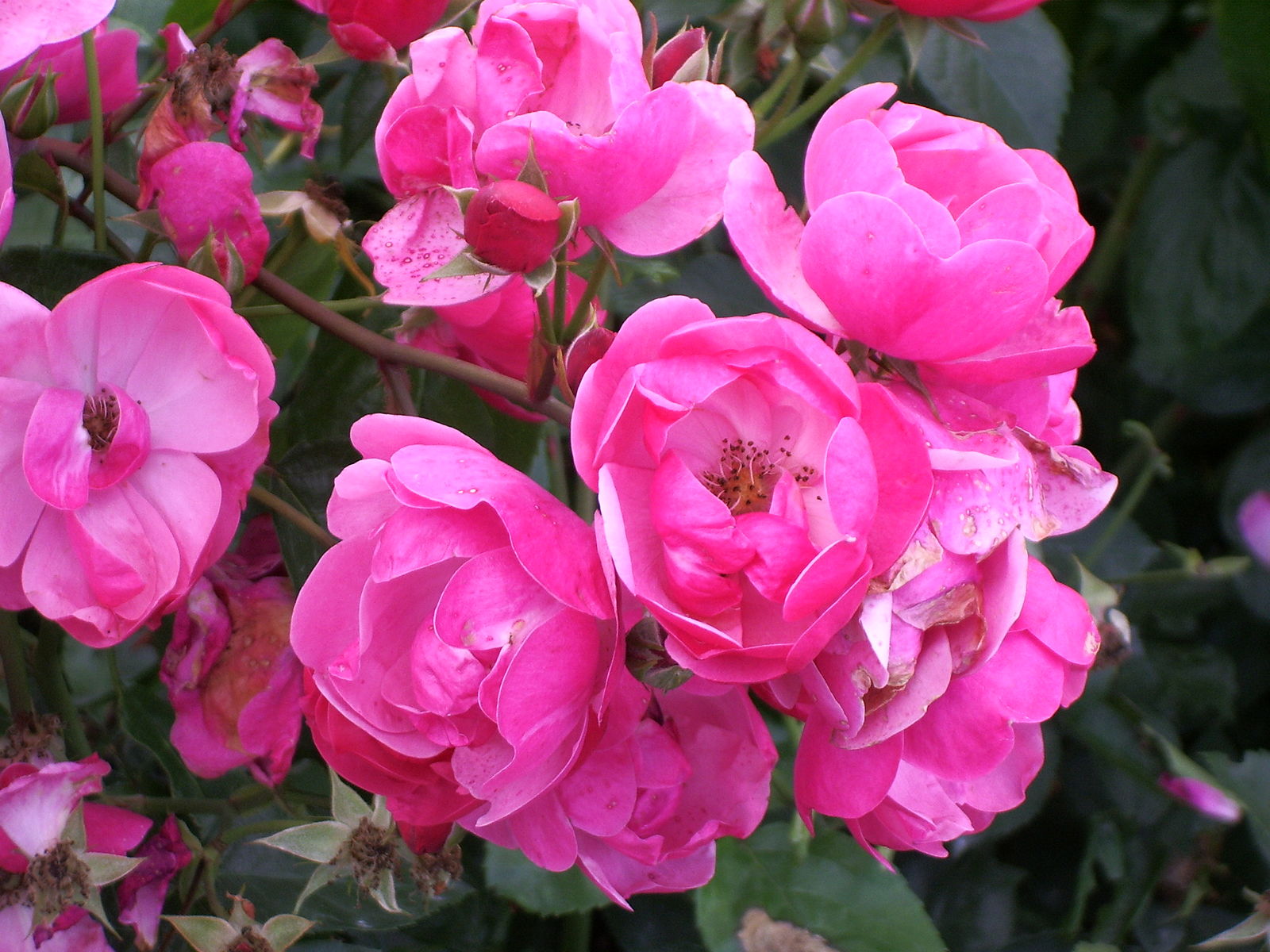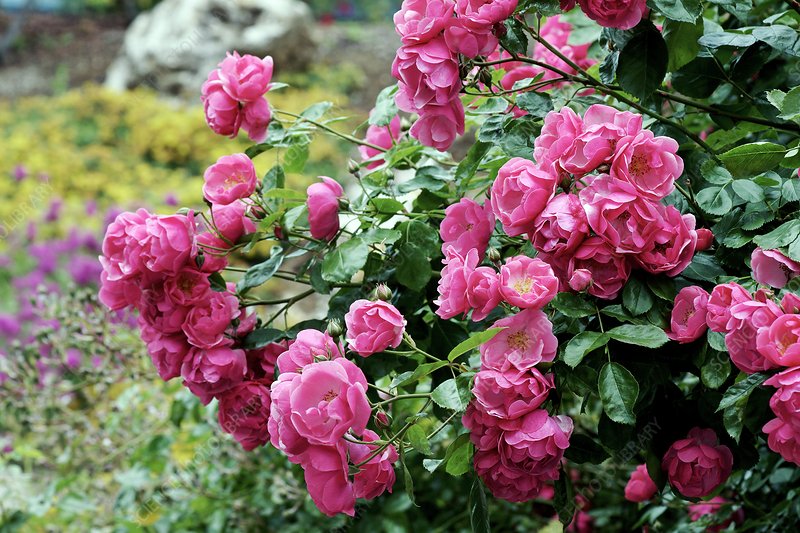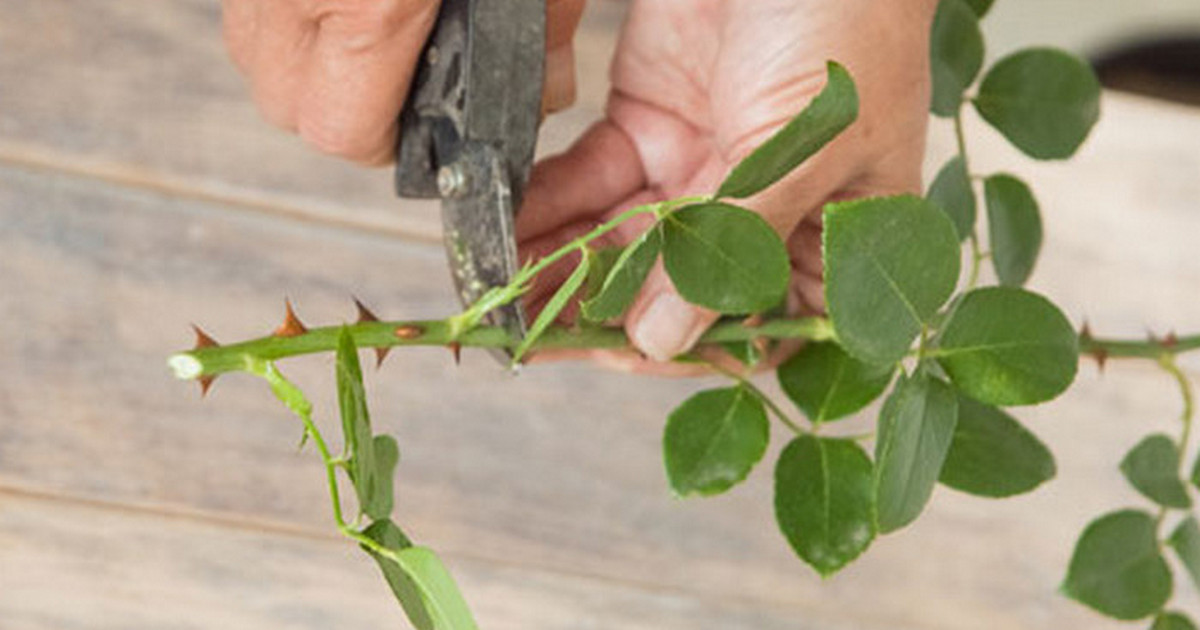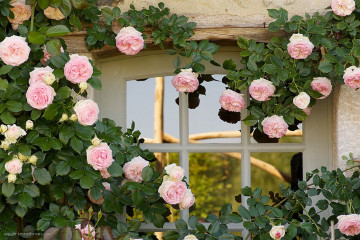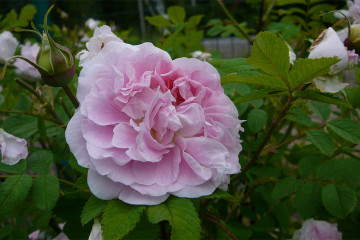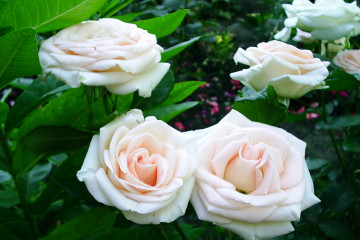Rose Angela (Angela) - characteristic of the variety
Content:
Among the extensive category of floribunda roses, Angela has been famous and popular for over 30 years. Raspberry petals and delicate fruity aroma are distinctive features of the variety.
Rose Angela (Angela)
For the first time the variety was presented to the general public in Germany in 1984. At the same time, a detailed description of this variety was given.
Angela scrub rose (that is, semi-pebbled) is obtained through complex selection from varieties bred in the German nurseries Yesterday and Peter Frankenfeld, who shared the authorship with each other.
The hybrid tea rose is widely recognized for its ability to easily adapt to local climatic conditions and to show consistently lush and colorful blooms, regardless of the weather.
The semi-double flower of 25 petals is cupped, but never fully revealed. Petals from pastel pink to deep crimson with edging. The bush is powerful. The stems stretch up to 1-1.5 m. An inflorescence of several flowers (from 5 to 21) is formed on the shoots. Corolla diameter - 6-10 cm. The leaf is dark green, matt, up to 17 cm long and up to 12 cm wide, of 5 leaves.
Having blossomed, the flower remains fresh for up to 2 weeks, and the inflorescence - up to 23 days. In total, the bush blooms for about 30 days, after which it is in a hurry to show the next buds. Flowering ends with the arrival of frost.
Advantages and disadvantages of the variety
Among the advantages, gardeners note:
- Long bloom - from June to October.
- The buds retain their elasticity for a long time (up to 2 weeks), including when cut.
- Disease resistance.
- There are many thorns, but they are small.
- Suitable for decorating flower beds and growing in containers.
- Transfers partial shade.
- Winter hardiness up to -30 ° С.
Disadvantages:
- Demanding on soil fertility and watering.
- Sprinkling should be done in the evening.
- Pruning is required in the fall.
Use in landscape design
The bush is formed by flexible branches. They can stretch up to 1-1.5 m in height or even up to 2 m in a favorable climate and with abundant feeding. They can be laid on various supports to form beautiful arches and pergolas.
Well-growing and perfectly amenable to cuttings, roses can be propagated very quickly even from 1 plant to get lush flower beds, borders. The beauty of the variety is that the bush looks exceptionally beautiful alone, as well as in a group planting with roses of other varieties and shades.
Growing a flower
If from the very beginning you create for a young plant all the conditions necessary for its active growth, then year after year it will delight with lush flowers and not cause serious trouble.
It is not recommended to propagate roses by seeds, since they require a long (3-6 months) period of stratification, after which the germination and survival rate of sprouts leaves much to be desired. For hybrid tea roses, this propagation method is almost never used.
Cutting is the best method. Its beauty is that seedlings obtained in spring bloom with a high probability in the same year.
What time is the boarding
The optimal time for planting in open ground or flowerpots is May. As soon as the probability of recurrent frosts has passed, you can plant. Shelter is not required, but to eliminate the risk of damage to the seedling, a cut 5-liter bottle is inserted around it (the lid must be removed), which will additionally create an optimal microclimate around the rose.
Location selection
The crown of this variety is strong, so there is no need to save the bushes from the wind, on the contrary, it is better to choose a blown place.
Sun is required for at least half daylight hours. Therefore, Angela is planted in a sunny meadow, or near fences and walls that give shade in the morning or evening.
How to prepare the soil and flower for planting
The seedling does not need preliminary preparation. If the root system is closed, then a simple transfer to the planting pit is done, and plants with an open root system can be soaked for prophylaxis (4-6 hours) in a solution of potassium permanganate or "Kornevin".
The soil of the rose needs nutritious, loose, well-retaining moisture. To do this, sand, humus, a little crushed charcoal, and peat are introduced into the soil.
The permissible range of soil acidity is pH = 5.6-7.3. Drainage is laid in abundance at the bottom of the planting pit, mixing broken brick, small tracing paper, expanded clay, sand.
Planting procedure step by step
As soon as the seedling is on hand, it is immediately planted, following the rules:
- Planting density - no more than 2 plants per 1 m2.
- All branches should be shortened to 20 cm.
- The planting hole is dug with a margin of width and depth in order to fill a drainage layer 15-20 cm thick.
- A support is stuck at the bottom for a bush garter.
- The seedling is buried so that the root collar is 5 cm deeper than the soil level.
Plant care
Healthy seedlings immediately start growing, which is immediately noticeable from them - the green mass increases in volume very quickly.
- Watering rules and humidity
Water the bushes when the topsoil dries up. Consumption - 8-10 liters of water for each plant. In the evenings, it is advisable to spray the crown with warm water.
- Top dressing
All the time of active growing season, 1 time every 2-3 weeks, planting is fed with potassium, nitrogen and phosphorus in a ratio of 1: 1: 2. These dressings alternate with organic ones, diluting bird droppings with water and infusing it for several days.
- Pruning and replanting
The optimal time for transplanting is spring (April).
Pruning is performed immediately after dropping the foliage in the fall, removing old and diseased shoots, and shortening healthy ones to 20-25 cm.
- Features of wintering a flower
At wintering temperatures above -20 ° C, shelters can be dispensed with. In winter frosts in the range from -20 ° C to -30 ° C, a shelter should be made by covering the bushes with agro-canvas or burlap. If even more severe frosts are possible, then the rose will have to be moved into the house.
Blooming rose
It is the blooming of buds that is the main goal of gardeners. For this, top dressing is introduced and the bushes are watered in the heat.
A period of activity and rest
In growth, the bushes get under way with the arrival of heat. When frosts can still return, the rose is already blooming (late April - early May). Since that time, there has been an active distillation of young shoots, leaves, buds. The rose blooms in early May, and ends flowering with the arrival of frost in early October.
At rest, from October to April, the root mass and buds of the next season are being formed. Roses wake up when the soil completely thaws and warms up above + 10 ° C.
Care during and after flowering
During the active forcing of buds, it is important to water, carry out regular feeding and cut wilted inflorescences.
This encourages the plant to continue flowering.
What to do if it does not bloom, possible reasons
If there are no buds, then the reasons are as follows:
- It's too dark. The bush needs to be dug up and transplanted to a lighter place.
- Too little nutrients, a complex mineral or organic fertilizer should be applied.
Flower propagation
It is very easy to get as much planting material from one seedling as you like. For this, young shoots of this year are cut for rooting.
The grafting process is fairly standard:
- The stalk is cut off at the crown of the shoot. Length 10-12 cm (neither shorter nor longer).
- On a high-quality cuttings there are 2-3 pairs of buds (in the axils of the leaves), and the crown with the buds is removed.
- The leaf plates are cut in half with scissors.
- The lower cut is made oblique, and the upper cut is straight.
- Rooted in water or directly in soil.
- For active forcing of roots, immediately after cutting, the cutting is kept for several hours in "Kornevin".
- If rooted in soil, then each stalk is covered with a cut bottle, opening its lid and sprayed with a spray bottle several times a day, making sure that the soil is always slightly moist.
- When rooting in water, sterility must be carefully monitored. The container is washed every day, and the water is changed to fresh (warm, filtered and boiled).
- If done correctly, the roots will appear in 3-4 weeks.
- A young seedling is planted in a permanent place when young shoots appear from the buds.
Diseases, pests and ways to control them
The variety is resistant to powdery mildew and fungal diseases.
The bushes are recommended to be processed in the same way as other tea roses:
- When suspicious spots appear, spray with a solution of soda ash (50 g per 10 l of water).
- Against diseases, the leaves are sprayed once a season with an interval of 10 days with a solution of Kemira Lux (1 tsp) and Epin (5 drops) in 5 liters of water.
- When rust appears on the leaves, they are treated with Oxyhom.
- Aphids are treated with "Alatar" or "Commander", which are effective insecticides against most pests of roses.
Rose with the romantic name Angela is a real beauty. It is loved for its pleasant light aroma and very long flowering period. Easy care and guaranteed results are her strengths. Novice gardeners should definitely pay attention to this variety.
